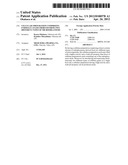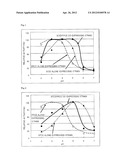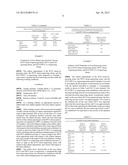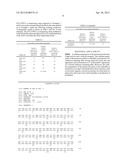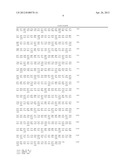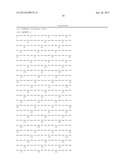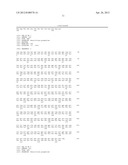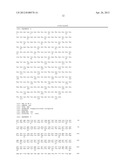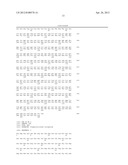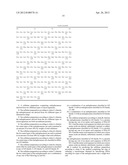Patent application title: CELLULASE PREPARATION COMPRISING ENDOGLUCANASES DERIVED FROM TWO DIFFERENT TYPES OF MICROORGANISMS
Inventors:
Kaoru Okakura (Odawara-Shi, JP)
Koichiro Murashima (Odawara-Shi, JP)
Assignees:
Meiji Seika Pharma Co., Ltd.
IPC8 Class: AC12P1900FI
USPC Class:
435 72
Class name: Chemistry: molecular biology and microbiology micro-organism, tissue cell culture or enzyme using process to synthesize a desired chemical compound or composition preparing compound containing saccharide radical
Publication date: 2012-04-26
Patent application number: 20120100578
Abstract:
By having a cellulase preparation comprising at least a certain amount of
endoglucanases derived from two different types of microorganisms, the
cellulase preparation can be provided with a higher activity and a wider
pH property than those of cellulase preparations each containing one of
the endoglucanases alone. Moreover, by introducing and expressing
simultaneously two different types of cellulase genes in a single host
cell, a cellulase preparation having a high activity and a wide pH
property can be produced easily.Claims:
1. A cellulase preparation comprising endoglucanases derived from two
different types of microorganisms.
2. The cellulase preparation according to claim 1, wherein the endoglucanases are derived from two different types of filamentous fungi.
3. The cellulase preparation according to claim 1, wherein the endoglucanases derived from the two different types of microorganisms are both recombinant proteins.
4. The cellulase preparation according to claim 1, wherein two main types of the endoglucanases are each contained in an amount of at least 10% by weight of total cellulases.
5. The cellulase preparation according to claim 4, wherein the two main types of the endoglucanases are each contained in an amount of at least 20% by weight of the total cellulases.
6. The cellulase preparation according to claim 1, wherein two main types of the endoglucanases are classified in different GH families.
7. The cellulase preparation according to claim 6, wherein each of the two main types of the endoglucanases is classified in any of GH family 5, GH family 12, and GH family 45.
8. The cellulase preparation according to claim 7, wherein the two main types of the endoglucanases are a combination of any one of the following (a) and (b): (a) a combination of an endoglucanase classified in GH family 5 with an endoglucanase classified in GH family 12; and (b) a combination of an endoglucanase classified in GH family 12 with an endoglucanase classified in GH family 45.
9. The cellulase preparation according to claim 8, wherein the endoglucanase classified in GH family 5 is a protein having any one of an amino acid sequence of SEQ ID NO: 2 and the amino acid sequence in which one or more amino acids are deleted, substituted, inserted, or added, the endoglucanase classified in GH family 12 is a protein having any one of an amino acid sequence of SEQ ID NO: 4 and the amino acid sequence in which one or more amino acids are deleted, substituted, inserted, or added, and the endoglucanase classified in GH family 45 is a protein having any one of an amino acid sequence of SEQ ID NO: 6 and the amino acid sequence in which one or more amino acids are deleted, substituted, inserted, or added.
10. A method for producing the cellulase preparation according to claim 3, the method comprising the step of culturing a transformant obtained by introducing DNAs encoding two types of the endoglucanases into a single host cell.
11. The method according to claim 10, wherein the host cell is a filamentous fungus.
12. A method for producing an improved cellulose-containing fiber, the method comprising the step of bringing a cellulose-containing fiber into contact with the cellulase preparation according to claim 1.
13. A method for producing a sugar from biomass, the method comprising the step of bringing a cellulose-containing biomass into contact with the cellulase preparation according to claim 1.
Description:
TECHNICAL FIELD
[0001] The present invention relates to a cellulase preparation comprising endoglucanases derived from two different types of microorganisms, a method for producing the cellulase preparation, and uses of the cellulase preparation.
BACKGROUND ART
[0002] Conventionally, a cellulose-containing fiber has been treated with cellulase to impart desired properties to the fiber. For example, in the textile industry, treatment with a cellulase is carried out to improve the touch feel and appearance of a cellulose-containing fiber, or to give a colored cellulose-containing fiber a "stonewashed" appearance providing local variations in color (Patent Literature 1).
[0003] Heretofore, in searching for cellulases utilized for such uses, components exhibiting a high activity for a cellulose-containing fiber have been isolated from cellulase composites produced by cellulase-producing fungi such as filamentous fungi. As a result, endoglucanases classified in GH family 5, GH family 12, and GH family 45 have been isolated as cellulases exhibiting a high activity mainly for a cellulose-containing fiber. For example, SCE3 derived from Trichoderma viride has been known as an endoglucanase classified in GH family 5 (Patent Literature 2); PPCE derived from Penicillium pinophilum has been known as an endoglucanase classified in GH family 12 (Patent Literature 3); STCE derived from Staphylotrichum cocosporum has been known as an endoglucanase classified in GH family 45 (Patent Literature 4); and so forth.
[0004] In a case where any of these cellulases is commercially produced, generally a transformant obtained by introducing genes encoding the cellulase into a microorganism such as a filamentous fungus is cultured, and a larger amount of the cellulase is expressed as a recombinant enzyme. In this case, the activity of a thus-prepared cellulase preparation for a cellulose-containing fiber depends on the activity of the recombinant cellulase expressed in a large amount. Similarly, the pH property of the cellulase preparation also depends on the properties of the recombinant cellulase expressed in the large amount. For example, in the case of SCE3, the optimum pH is weakly acidic (Patent Literature 2), while, in the case of PPCE, the optimum pH is acidic (Patent Literature 3). Accordingly, cellulase preparations obtained by expressing large amounts of SCE3 and PPCE as recombinant enzymes exhibit the same pH properties as those of SCE3 and PPCE, respectively.
[0005] So far, in order to improve the activity of and modify the properties of a cellulase preparation, attempts have been made mainly to search for a novel cellulase exhibiting desired properties and to modify known cellulases through a protein engineering approach. However, to obtain a cellulase exhibiting an activity significantly superior to known cellulases, first, a novel microorganism has to be isolated, which is not easy to do. Further, the possibility that the microorganism or the like produces a cellulase having desired properties is low. In addition, even if mutation is introduced into a known cellulase through a protein engineering approach, it is difficult to drastically modify the properties of the known cellulase. Due to these problems, conventionally and at present, a cellulase preparation having both a high activity and an excellent pH property has yet to be obtained.
CITATION LIST
Patent Literature
[0006] [PTL 1] European Patent No. 307564
[0007] [PTL 2] International Publication No. W098/54332
[0008] [PTL 3] International Publication No. W02008/111613
[0009] [PTL 4] International Publication No. W02005/054475
SUMMARY OF INVENTION
Technical Problem
[0010] The present invention has been made in view of such circumstances. An object of the present invention is to provide a cellulase preparation having a high activity and an excellent pH property. Another object of the present invention is to provide a method for easily producing such a cellulase preparation.
Solution to Problem
[0011] The present inventors have earnestly studied in order to solve the above problems. As a result, it was found out that by producing a cellulase preparation comprising at least certain proportions of endoglucanases derived from two different types of filamentous fungi, a surprisingly higher activity for a cellulose-containing fiber was obtained than cellulase preparations each obtained by expressing one of the endoglucanases alone. Particularly, if a cellulase preparation comprised as main cellulases a combination of SCE3 (classified in GH family 5) derived from Trichoderma viride with PPCE (classified in GH family 12) derived from Penicillium pinophilum, or a combination of PPCE derived from Penicillium pinophilum with STCE (classified in GH family 45) derived from Staphylotrichum cocosporum, an activity for a cellulose-containing fiber was significantly increased. Moreover, the pH property of the cellulase preparation obtained as described above shows a wider profile than the cellulase preparations obtained by expressing one of the endoglucanases alone. It was revealed that a combination of the two types of the endoglucanases made it possible to modify the pH property of the cellulase preparation. Further, the present inventors found out that, in production of such a cellulase preparation, if DNAs encoding endoglucanases derived from two different types of microorganisms were introduced and expressed in a single host cell, the ratio of the recombinant endoglucanases to secreted proteins is increased, and a culture supernatant having a high activity was obtained, in comparison with a case where each of the endoglucanases was introduced and expressed in a host cell alone.
[0012] Specifically, the present invention relates to a cellulase preparation comprising endoglucanases derived from two different types of microorganisms, a method for producing the cellulase preparation, and uses of the cellulase preparation. More specifically, the present invention provides the followings. [0013] (1) A cellulase preparation comprising endoglucanases derived from two different types of microorganisms. [0014] (2) The cellulase preparation according to (1), wherein the endoglucanases are derived from two different types of filamentous fungi. [0015] (3) The cellulase preparation according to (1), wherein the endoglucanases derived from the two different types of microorganisms are both recombinant proteins. [0016] (4) The cellulase preparation according to anyone of (1) to (3), wherein two main types of the endoglucanases are each contained in an amount of at least 10% by weight of total cellulases. [0017] (5) The cellulase preparation according to (4), wherein the two main types of the endoglucanases are each contained in an amount of at least 20% by weight of the total cellulases. [0018] (6) The cellulase preparation according to any one of (1) to (3), wherein two main types of the endoglucanases are classified in different GH families. [0019] (7) The cellulase preparation according to (6), wherein each of the two main types of the endoglucanases is classified in any of GH family 5, GH family 12, and GH family 45. [0020] (8) The cellulase preparation according to (7), wherein the two main types of the endoglucanases are a combination of any one of the following (a) and (b): [0021] (a) a combination of an endoglucanase classified in GH family 5 with an endoglucanase classified in GH family 12; and [0022] (b) a combination of an endoglucanase classified in GH family 12 with an endoglucanase classified in GH family 45. [0023] (9) The cellulase preparation according to (8), wherein the endoglucanase classified in GH family 5 is a protein having any one of an amino acid sequence of SEQ ID NO: 2 and the amino acid sequence in which one or more amino acids are deleted, substituted, inserted, or added,
[0024] the endoglucanase classified in GH family 12 is a protein having any one of an amino acid sequence of SEQ ID NO: 4 and the amino acid sequence in which one or more amino acids are deleted, substituted, inserted, or added, and
[0025] the endoglucanase classified in GH family 45 is a protein having any one of an amino acid sequence of SEQ ID NO: 6 and the amino acid sequence in which one or more amino acids are deleted, substituted, inserted, or added. [0026] (10) A method for producing the cellulase preparation according to (3), the method comprising the step of culturing a transformant obtained by introducing DNAs encoding two types of the endoglucanases into a single host cell. [0027] (11) The method according to (10), wherein the host cell is a filamentous fungus. [0028] (12) A method for producing an improved cellulose-containing fiber, the method comprising the step of bringing a cellulose-containing fiber into contact with the cellulase preparation according to any one of (1) to (3). [0029] (13) A method for producing a sugar from biomass, the method comprising the step of bringing a cellulose-containing biomass into contact with the cellulase preparation according to any one of (1) to (3).
Advantageous Effects of Invention
[0030] The present invention provides a cellulase preparation exhibiting a high activity and an activity in a wide pH range. Moreover, the present invention provides a method for easily producing such a cellulase preparation. The use of the cellulase preparation obtained according to the present invention enables, for example, efficient improvement in touch feel and appearance of a cellulose-containing fiber and saccharification of biomass.
BRIEF DESCRIPTION OF DRAWINGS
[0031] FIG. 1 is a graph showing the result of analyzing pH properties in the fuzz-removing activities of a SCE3 alone-expressing strain, a PPCE alone-expressing strain, and a SCE3PPCE co-expressing strain.
[0032] FIG. 2 is a graph showing the result of analyzing pH properties in the fuzz-removing activities of a STCE alone-expressing strain, the PPCE alone-expressing strain, and a STCEPPCE co-expressing strain.
DESCRIPTION OF EMBODIMENTS
Cellulase Preparation
[0033] In the present invention, a cellulase refers to an enzyme having an activity of breaking down cellulose, and a cellulase preparation refers to a preparation comprising cellulase components such as cellobiohydrolases, endoglucanases, and β-glucosidase.
[0034] The cellulase preparation of the present invention is characterized by comprising endoglucanases derived from two different types of microorganisms. The two different types of microorganisms from which the endoglucanases are derived are preferably two different types of filamentous fungi. Examples of the filamentous fungi include those belonging to genera Trichoderma, Penicillium, Staphylotrichum, Humicola, Acremonium, Aspergillus, Rizopus, Mucor, and Phycomyces. Preferable examples thereof include Trichoderma viride, Penicillium pinophilum, Staphylotrichum cocosporum, Humicola insolens, Acremonium cellulolyticus, Aspergillus niger, Aspergillus aculeatus, Rizopus oryzae, Mucor circinelloides, and Phycomyces nitens.
[0035] Preferably, two main types of the endoglucanases comprised in the cellulase preparation of the present invention are derived from different microorganisms, and are selected from endoglucanases classified in different GH families. Herein, the "main endoglucanase" refers to an endoglucanase having the highest protein weight among the endoglucanases comprised in the cellulase preparation. Thus, the "two main types of the endoglucanases" refer to an endoglucanase having the highest protein weight and an endoglucanase having the second highest protein weight among the endoglucanases comprised in the cellulase preparation. The protein weight can be calculated as follows. Specifically, SDS-PAGE is carried out on the cellulase preparation, and the concentration (protein amount) of each protein band in a migrating image is analyzed by densitometry. Note that a certain endoglucanase includes one that is broken down and one that is not broken down. Accordingly, in the analysis on a migrating image of SDS-PAGE, a translated product of the same endoglucanase gene may be observed as an irrelevant band. In the present invention, even if irrelevant bands are detected in a migrating image of SDS-PAGE, in a case where the translated products come from the same endoglucanase gene, these are evaluated as the endoglucanase of the same type, and the protein weight is calculated accordingly.
[0036] Each of the endoglucanases classified in the different GH families are desirably selected from endoglucanases classified in any of GH family 5, GH family 12, and GH family 45. Herein, "GH family" is a classification based on the primary structure of a glycoside hydrolase. Specifically, the endoglucanases are classified by a method described in the WEB page of CAZY (http://www.cazy.org/fam/accGH.html).
[0037] An example of the endoglucanase classified in GH family 5 is SCE3 derived from Trichoderma viride. In this respect, a naturally-occurring protein typical of "SCE3" is represented by an amino acid sequence of SEQ ID NO: 2. In the present invention, nevertheless, the protein may have the amino acid sequence of SEQ ID NO: 2 in which one or more amino acids are deleted, substituted, inserted, or added, as long as the endoglucanase activity is exhibited.
[0038] Moreover, an example of the endoglucanase classified in GH family 12 is PPCE derived from Penicillium pinophilum. In this respect, a naturally-occurring protein typical of "PPCE" is represented by an amino acid sequence of SEQ ID NO: 4. In the present invention, nevertheless, the protein may have the amino acid sequence of SEQ ID NO: 4 in which one or more amino acids are deleted, substituted, inserted, or added, as long as the endoglucanase activity is exhibited.
[0039] Further, an example of the endoglucanase classified in GH family 45 is STCE derived from Staphylotrichum cocosporum. In this respect, a naturally-occurring protein typical of "STCE" is represented by an amino acid sequence of SEQ ID NO: 6. In the present invention, nevertheless, the protein may have the amino acid sequence of SEQ ID NO: 6 in which one or more amino acids are deleted, substituted, inserted, or added, as long as the endoglucanase activity is exhibited.
[0040] The "one or more amino acids" modified in the endoglucanase are normally 50 amino acids or less, preferably 30 amino acids or less, and further preferably 10 amino acids or less (for example, 5 amino acids or less, or 3 amino acids or less). In a case where a certain amino acid of the endoglucanase is substituted with another amino acid, the substitution is preferably a substitution between amino acids having similar properties (conservative substitution) so that the endoglucanase activity can be maintained.
[0041] In the present invention, a combination of the two main types of the endoglucanases comprised in the cellulase preparation is particularly preferably a combination of SCE3 with PPCE or a combination of PPCE with STCE.
[0042] For example, the combination of SCE3 with PPCE can exhibit a surprisingly high fuzz-removing activity. The relative activity with respect to total cellulase amounts is approximately 2.4 to 3.0 times as high as a case where each endoglucanase is expressed alone. In addition to such a significant synergy effect, the pH property of the cellulase preparation obtained with this combination exhibits a wider profile than the case where each endoglucanase is expressed alone. Particularly, even if the pH is higher than 4, a high fuzz-removing activity at a level equivalent to a case of the optimum pH can be obtained in a certain pH range. For example, in a case where SCE3 is expressed alone, the fuzz-removing activity at pH 5 is approximately 75% of that at the optimum pH. In a case where PPCE is expressed alone, the fuzz-removing activity at pH5 is approximately 30% of that at the optimum pH. In a case where the two are combined, an equivalent activity to the fuzz-removing activity at the optimum pH can be exhibited even at pH 5. Herein, the "equivalent activity" means an activity of at least 90% or higher, preferably 95% or higher, and most preferably 100%. As described above, the combination of SCE3 with PPCE is characterized also by exhibiting the advantageous properties that cannot be expected from the pH property of each endoglucanase alone.
[0043] Additionally, for example, the combination of PPCE with STCE can exhibit a high fuzz-removing activity. The relative activity with respect to total cellulase amounts is approximately 3.2 to 3.7 times as high as a case where each endoglucanase is expressed alone. In addition to such a significant synergy effect, the pH property of the cellulase preparation obtained with this combination exhibits a wider profile than the case where each endoglucanase is expressed alone.
[0044] The cellulase preparation of the present invention comprising the two main types of the endoglucanases has a relatively high activity and a modified pH property in comparison with the case where each endoglucanase is expressed alone.
[0045] To increase the activity of the cellulase preparation in an absolute sense, the cellulase preparation comprises the two main types of the endoglucanases in an amount of at least 10% by weight (of total cellulases), further preferably at least 20% by weight. For the combination of SCE3 with PPCE, the cellulase preparation may comprise SCE3 in an amount of at least 40o by weight and PPCE in an amount of at least 20% by weight, for example. Moreover, for the combination of PPCE with STCE, the cellulase preparation may comprise PPCE in an amount of at least 15% by weight and STCE in an amount of at least 25% by weight, for example
[0046] Herein, the "total cellulases" refer to a total weight of cellobiohydrolases, endoglucanases, and β-glucosidase comprised in the cellulase preparation. For example, in a case where an endoglucanase is expressed as a recombinant protein in Trichoderma viride strain 2 as a host, the amount of the total cellulases is the total weight of CBH1 and CBH2 as the cellobiohydrolases, EG1, SCE3, and endoglucanase (GH family 74) as the endoglucanases, and BGL as the β-glucosidase derived from the host in addition to the recombinant endoglucanase.
DNAs Encoding Endoglucanases and Acquisition thereof
[0047] In the present invention, a DNA encoding an endoglucanase refers to a DNA encoding the amino acid sequence of the above-described endoglucanase.
[0048] In the present invention, the DNA encoding the endoglucanase can be obtained artificially by chemical synthesis based on a base sequence of an endoglucanase gene or the amino acid sequence of the endoglucanase. Moreover, the DNA encoding the endoglucanase of the present invention can be amplified, using a primer synthesized based on a base sequence of a known endoglucanase gene or an amino acid sequence of a known endoglucanase, by PCR with a template of a DNA containing the gene, such as genomic DNA, cDNA, and plasmid. Further, the DNA encoding the endoglucanase of the present invention can also be obtained, using a gene fragment of the endoglucanase, as a probe, synthesized based on a base sequence of a known endoglucanase gene or an amino acid sequence of the known endoglucanase, by screening a genomic DNA library or cDNA library containing the endoglucanase gene for positive clones containing the endoglucanase gene.
[0049] In addition, to express the DNA encoding the endoglucanase to be introduced in a host cell as the endoglucanase having an activity, the DNA encoding the endoglucanase preferably contains, for example, a base sequence for regulating the expression or a genetic marker for selecting a transformant. Examples of the base sequence for regulating the expression include base sequences encoding a promoter, terminator, and signal peptide; and the like. The promoter is not particularly limited, as long as the transcriptional activity is exhibited in the host cell. The promoter can be obtained as a base sequence for regulating the expression of a gene encoding a protein that is either homologous or heterologous to the host cell. Moreover, the signal peptide is not particularly limited, as long as the signal peptide contributes to secretion of the protein in the host cell. The signal peptide can be obtained from a base sequence derived from the gene encoding the protein that is either homologous or heterologous to the host cell.
Host Cell and Transformation thereof
[0050] As the host cell into which the DNA encoding the endoglucanase is introduced in the present invention, E. coli, Actinomycetes, yeasts, filamentous fungi, and the like can be utilized. Filamentous fungi excellent in protein productivity are preferably used. Moreover, as the filamentous fungi used as the host cell, those belonging to genera Humicola, Aspergillus, Trichoderma, Fusarium, Acremonium, and Penicillium can be utilized. Furthermore, preferable examples thereof include Humicola insolens, Aspergilluss niger, Aspergillus oryzae, Trichodermaviride, Fusarium oxysporum, Acremonium cellulolyticus, and Penicillium pinophilum.
[0051] In the present invention, the DNA encoding the endoglucanase can be introduced into the host cell by a method in which the DNA encoding the endoglucanase is directly introduced, as well as a method in which the host cell is transformed with an expression vector which is replicable in the host cell and which contains a gene encoding the cellulase in an expressable state. The expression vector used for the transformation of the host cell can be constructed based on a self-replicating vector, i.e., for example, a plasmid which exists as an extrachromosomal element, and which replicates independently of the replication of the chromosome. Alternatively, the expression vector may be replicated together with the chromosome of the host microorganism, after introduced into the host microorganism and incorporated into the genome thereof. As a procedure and a method for constructing the vector according to the present invention, any procedure and any method commonly used in the field of genetic engineering can be used.
[0052] In the present invention, the transformation of the host cell with the DNA encoding the endoglucanase and the expression vector can be carried out according to any method commonly used in this field. The method of introducing the DNA encoding the endoglucanase into the host cell is carried out by introducing DNAs encoding two types of the endoglucanases or expression vectors containing these into the host cell simultaneously. Alternatively, the two types of the cellulase genes or the expression vectors containing these may be introduced into the host cell in a stepwise manner; specifically, one of the DNAs encoding the endoglucanases to be introduced or one of the expression vectors containing these is first introduced into the host cell, and subsequently, the other of the DNAs encoding the endoglucanases or the other of the expression vectors is introduced in a resultant transformant. Beside, a genetic marker used in the transformation may be selected as appropriate according to the method of selecting the transformant. For example, a gene encoding drug resistance or a gene complementing the auxotrophy can be used.
Production of Cellulase Preparation
[0053] The cellulase preparation of the present invention can be produced as follows. Specifically, the above-described transformed host cell is cultured in an appropriate medium, and recombinant cellulases are obtained from the resultant culture. The culturing and conditions for the host cell expressing the two types of the recombinant endoglucanases may be substantially the same as those for the host cell used.
Uses of Cellulase
[0054] In the present invention, when a cellulose-containing fiber is treated with the cellulase preparation or a cellulase agent utilizing the same, a cellulose-containing fiber having improved touch feel and appearance can be produced. It is also possible to give a colored cellulose-containing fiber a "stonewashed" appearance providing local variations in color.
[0055] Furthermore, according to the present invention, when biomasses, such as rice straw, bagasse, corn stover, pomace of a fruit such as a palm seed, and waste wood, are treated with the recombinant cellulase preparation or the cellulase agent utilizing the same, a sugar can be produced (saccharification) from these biomasses. The sugar obtained in this manner can be further converted into ethanol by fermentation with a yeast or the like.
EXAMPLES
[0056] The present invention will be more specifically described by way of Examples, but the present invention is not to be limited to Examples below but is still within the gist of the present invention.
Example 1
Preparing of Trichoderma viride Co-Expressing Endoglucanase SCE3 and Endoglucanase PPCE
[0057] (1) Construction of SCE3-Expression Plasmid pCB1-sce3
[0058] As an expression vector for the endoglucanase SCE3 derived from Trichoderma viride, pCB1-sce3 was used which was obtained by self-ligation of a fragment of approximately 7 kb obtained by digesting pCB1-Eg3X described in International Publication No. WO98/11239 with XbaI. [0059] (2) Construction of PPCE-Expression Plasmid pPPCE-M
[0060] As an expression vector for the endoglucanase PPCE derived from Penicillium pinophilum, pPPCE-M described in WO 2008/11613 was used. [0061] (3) Construction of Selection Marker-Expression Plasmid pPYR4
[0062] As a marker plasmid containing a pyr4 gene derived from Neurospora crassa, pPYR4 described in International Publication No. WO2005/056787 was used. [0063] (4) Construction of Selection Marker-Expression Plasmid pDT-118
[0064] A plasmid pDT-118 was constructed by inserting, into an XbaI site of pUC118 (manufactured by TAKARA SHUZO CO., LTD.), a destomycin resistance gene (DtR) derived from Streptomyces rimofacience having a promoter and a terminator of an Aspergillus nidulans-derived trpC gene excised from pMKD01described in International Publication No. WO98/03667 with XbaI. [0065] (5) Creation and Culturing of SCE3 alone-expressing strain
[0066] Transformation of Trichoderma viride with the plasmid pCB1-sce3 obtained in Example 1--(1) and the plasmid pPYR4 obtained in Example 1--(3) was carried out in accordance with the method described in WO 2005/056787. Specifically, this transformation was carried out by a co-transformation method using Trichoderma viride strain 2 deficient in a gene for uracil biosynthesis (pyr4) as a host and a pyr4 gene of Neurospora crassa as a selection marker. First, in accordance with the method described in WO 2005/056787, protoplasts of Trichoderma viride strain 2 were prepared, and 100 μL of the protoplast suspension thus obtained was mixed with 7 μg of pCB1-sce3 and 3 μg of pPYR4. After the liquid mixture was allowed to stand on ice for 5 minutes, 400 μL of a PEG solution (60% polyethylene glycol 4000, 10 mM calcium chloride, and 10 mM Tris-HCl buffer, pH 7.5) was added to the mixture, which was further allowed to stand on ice for 20 minutes. The protoplast suspension thus treated was washed with an SUTC buffer (0.5 M sucrose, 10 mM calcium chloride, and 10 mM Tris-HCl buffer, pH 7.5), and then overlaid with soft agar on a minimum medium containing 0.5 M of sucrose, followed by culturing at 28° C. for 5 days. After the culturing, grown colonies were again transferred on a minimum medium, and colonies grown on this medium was used as transformants. From the obtained transformants, 200 strains were inoculated into a PSW medium (1.0% glucose, 4.0% lactose, 2.0% soybean cake, 1.0% wheat germ, 0.2% potassium dihydrogen phosphate, 0.2% ammonium sulfate, 0.2% ammonium phosphate, and 0.2% calcium carbonate), and cultured at 28° C. for 5 days. After the culturing, mycelia were removed by centrifugation to obtain culture supernatants as crude enzyme solutions. The crude enzyme solutions were subjected to SDS-PAGE. This SDS-PAGE was carried out using an electrophoresis apparatus Safety Cell Mini STC-808 (manufactured by TEFCO) and Precast Mini Gel 12%-SDS-PAGE mini, 1.0 mm in gel thickness (manufactured by TEFCO). The electrophoresis method was carried out in accordance with protocols attached to the products. LMW Calibration For SDS Electrophoresis (manufactured by GE Healthcare Bio-Sciences) was used as a molecular weight marker. After the electrophoresis, in accordance with protocols attached thereto, Coomassie Brilliant Blue R250 (manufactured by NACALAI TESQUE, INC.) was used for staining, followed by decolorization. As a result, a protein of 45 kDa was expressed specifically in the transformants. Strain 2-99 having a particularly high expression amount was designated as a SCE3 alone-expressing strain. [0067] (6) Creation and Culturing of SCE3PPCE Co-Expressing strain
[0068] The SCE3 alone-expressing strain obtained in Example 1--(5) was transformed with pPPCE-M obtained in Example 1--(2) and pDt-118 obtained in Example 1--(4). The transformation method followed the method in Example 1--(5), and this transformation was carried out by a co-transformation method using the SCE3 alone-expressing strain as a host and the destomycin resistance gene (DtR) as a selection marker. The SCE3 alone-expressing strain was transformed using 7 μg of pPPCE-M and 3 μg of pDt-118, and overlaid with PDA agar on a PDA medium containing 20 μg/ml hygrpmycin B, followed by culturing at 28° C. for 5 days. After the culturing, grown colonies were again transferred on a PDA medium containing hygrpmycin B, and colonies grown on this medium was used as transformants. Thus, 70 strains of the transformants were obtained. From the obtained transformants, the 70 strains were inoculated into a PSW medium described in Example 1--(5), and cultured at 28° C. for 5 days. After the culturing, mycelia were removed by centrifugation to obtain culture supernatants as crude enzyme solutions. The crude enzyme solutions were subjected to SDS-PAGE, and a protein of approximately 26 kDa was specifically expressed in the transformants. Strain 11-8 having a particularly high expression amount was designated as a SCE3PPCE co-expressing strain. [0069] (7) Creation and Culturing of PPCE Alone-Expressing strain
[0070] Transformation of Trichoderma viride strain 2 with pPPCE-M obtained in Example 1--(2) and pPYR4 obtained in Example 1--(3) was carried out in accordance with the method described in Example 1--(5). Specifically, Trichoderma viride strain 2 was transformed using 7 μg of pPPCE-M and 3 μg of pPYR4, and overlaid with soft agar on a minimum medium, followed by culturing at 28° C. for 5 days. After the culturing, grown colonies were again transferred on a minimum medium, and colonies grown on this medium were used as transformants. The obtained transformants were cultured by the method described in Example 1--(5). The strain which expressed a significant amount of PPCE was designated as a PPCE alone-expressing strain. [0071] (8) Measurement of Expressed Protein Concentration
[0072] The SCE3 alone-expressing strain, the PPCE alone-expressing strain, and the SCE3PPCE co-expressing strain were evaluated in terms of the amount of recombinant endoglucanase expressed. The total protein amount of each of the culture supernatants was measured using BIO-RAD Protein Assay Kit (manufactured by Bio-Rad Inc.) in accordance with protocols attached thereto. Subsequently, electrophoresis was carried out on the culture supernatant in an amount of 11 g as the protein amount by the method described in Example 1--(5). Bands were analyzed using Molecular Imager FX (manufactured by Bio-Rad Laboratories, Inc.) and Quantity One (manufactured by Bio-Rad Laboratories, Inc.) to determine a ratio of the expressed cellulase to the total cellulase components. Here, the conditions for the band analysis were: sensitivity of 7.513 and rolling disk size of 10. Table 1 shows the result. From this result, in the SCE3PPCE co-expressing strain, SCE3 and PPCE were two main types of the endoglucanases, and the ratios to the total cellulases were respectively 40.8% and 20.2%.
[0073] Additionally, as shown in Table 1, in the case where both SCE3 and PPCE were simultaneously expressed, a culture supernatant having a higher recombinant endoglucanase ratio was obtained than the case where each endoglucanase was expressed alone.
TABLE-US-00001 TABLE 1 Ratios of protein components in Trichoderma viride strain 2 recombinants PPCE SCE3 PPCE SCE3 alone- alone- co- expressing expressing expressing strain strain strain Endoglucanase 0.7% 1.6% 0.5% (GH family 74) BGL 2.7% 2.8% 1.8% CBH1 16.9% 21.4% 15.4% CBH2 6.2% 12.8% 3.9% EG1 -- 4.5% -- SCE3 44.9% 6.0% 40.8% PPCE 0% 29.8% 20.2% Recombinant 44.9% 29.8% 61.0% endoglucanase ratio
Example 2
Comparison of Fuzz-Removing Activities Among SCE3 Alone-Expressing Strain, PPCE Alone-Expressing Strain, and SCE3PPCE Co-Expressing Strain
[0074] The culture supernatants of the SCE3 alone-expressing strain, the PPCE alone-expressing strain, and the SCE3PPCE co-expressing strain prepared in Example 1 were used to examine the fuzz-removing activities under the following washing conditions.
Conditions
[0075] Testing machine: Launder Meter L-12 (manufactured by DAIEI KAGAKU SEIKI MFG. CO., LTD.)
[0076] Temperature: 40° C.
[0077] Time: 60 minutes
[0078] Reaction solution: 5 mmol/L acetic acid buffer (pH 4) 40 ml
[0079] To a treating solution, an appropriate amount of rubber balls were added together with each culture supernatant.
[0080] After washing, extents of fuzz removed were judged visually, and the amounts of culture supernatants required to remove approximately 50% of fuzz on the basis of a visual evaluation were calculated. Relative activities were determined from the liquid amounts, where the fuzz-removing activity of the culture supernatant of the PPCE alone-expressing strain was regarded as 100%. In addition, from the result of Example 1, the total cellulase weights in the culture supernatants were calculated, and relative fuzz-removing activities with respect to the total cellulase amounts were calculated. As a result, as shown in Table 2, the SCE3PPCE co-expressing strain containing both recombinant endoglucanases of SCE3 and PPCE exhibited activities 4.1 times as high as the PPCE alone-expressing strain with respect to the culture supernatant, and 2.4 times with respect to the total cellulases. Further, the SCE3PPCE co-expressing strain exhibited activities 5.1 times as high as the SCE3 alone-expressing strain with respect to the culture supernatant, and 3 times with respect to the total cellulases.
[0081] The results above showed that in the case where SCE3 and PPCE were co-expressed, a synergistically high fuzz-removing activity was obtained in comparison with the case where each endoglucanase was expressed alone.
TABLE-US-00002 TABLE 2 Comparison of fuzz-removing activities among SCE3 alone-expressing strain, PPCE alone-expressing strain, and SCE3 PPCE co-expressing strain Relative activity with Relative activity respect to with respect to culture total cellulases Enzyme supernatant (%) (%) SCE3 alone- 80 80 expressing strain PPCE alone- 100 100 expressing strain SCE3 PPCE co- 410 240 expressing strain
Example 3
Analysis of pH Properties in Fuzz-Removing Activities of SCE3 Alone-Expressing Strain, PPCE Alone-Expressing Strain, and SCE3PPCE Co-Expressing Strain
[0082] The culture supernatants of the SCE3 alone-expressing strain, the PPCE alone-expressing strain, and the SCE3PPCE co-expressing strain used in Example 1 was used to investigate the pH property of each enzyme in accordance with the method described in Example 2. Consequently, results as shown in Table 3 and FIG. 1 were obtained. The SCE3PPCE co-expressing strain exhibited a wider pH profile where the high activity was maintained from weak acid to acid than the alone-expressing strains. In particular, surprisingly, in the case where SCE3 was expressed alone, the fuzz-removing activity at pH 5 was approximately 75% of that at the optimum pH. In the case where PPCE was expressed alone, the fuzz-removing activity at pH 5 was approximately 30% of that at the optimum pH. Meanwhile, in the case where the two were combined, the fuzz-removing activity at pH 5 was exhibited to be equivalent to the activity at the optimum pH.
TABLE-US-00003 TABLE 3 pH profile of each culture supernatant Relative Relative Relative activity of activity of activity of SCE3 alone- PPCE alone- SCE3 PPCE expressing expressing co-expressing Buffer, pH strain (%) strain (%) strain (%) citric acid, 50 85 35 pH 2 acetic acid, 70 100 100 pH 3 acetic acid, 100 90 100 pH 4 acetic acid, 75 30 100 pH 5 acetic acid, 15 10 or less 20 pH 6 Phosphoric 15 10 or less 10 or less acid, pH 7
Example 4
Preparing of Trichoderma Viride Co-Expressing Endoglucanase STCE and Endoglucanase PPCE
[0083] (1) Construction of STCE-Expression pCB-Stm12
[0084] As an expression vector for the endoglucanase STCE derived from Staphylotrichum cocosporum, pCB-Stml2 described in Example B4 of WO 2005/056787 was used. [0085] (2) Creation of STCE Alone-Expressing strain
[0086] Transformation of Trichoderma viride with the plasmid pCB-stm12 and the plasmid pPYR4 and culturing of the transformants were carried out by the same method as described in Example 1--(5). The method described in WO 2005/056787 was followed. From the obtained transformants of 80 strains, crude enzyme solutions were prepared, and subjected to SDS-PAGE in accordance with Example 1--(5). As a result, a protein of 45 kD was expressed specifically in the transformants. Strain m12-60 having a particularly high expression amount was designated as a STCE alone-expressing strain. [0087] (3) Creation of STCEPPCE Co-Expressing strain
[0088] The STCE alone-expressing strain created in Example 4--(2) was transformed with pPPCE-M obtained in Example 1--(2) and pDT-118 obtained in Example 1--(4). As the transformation method, this trans format ion was carried out in accordance with the method in Example 1--(5). From the obtained transformants, 70 strains were cultured by the method described in Example 1--(5), and crude enzyme solutions were prepared. The crude enzyme solutions were subjected to SDS-PAGE, and a protein of approximately 26 kD was expressed specifically in the transformants. Strain 10-82 having a particularly high expression amount was designated as a STCEPPCE co-expressing strain. [0089] (4) Measurement of Expressed Protein Concentration
[0090] By the method described in Example 1--(8), the STCE alone-expressing strain, the PPCE alone-expressing strain, and the STCEPPCE co-expressing strain were evaluated in terms of the amount of cellulase component expressed. Table 4 shows the result. From this result, in the STCEPPCE co-expressing strain, STCE and PPCE were two main types of the endoglucanases, and the ratios to the total cellulases were respectively 25.5% and 18.5%. Additionally, in the case where both STCE and PPCE were simultaneously expressed, a culture supernatant having a higher recombinant endoglucanase ratio was obtained than the case where each endoglucanase was expressed alone.
TABLE-US-00004 TABLE 4 Ratios of protein components in Trichoderma viride strain 2 recombinants STCE STCE PPCE alone- PPCE alone- co- expressing expressing expressing strain strain strain Endoglucanase 1.3% 1.6% 1.7% (GH family 74) BGL 4.3% 2.8% 3.1% CBH1 19.8% 21.4% 14.5% CBH2 14.4% 12.8% 7.4% EG1 5.5% 4.5% 4.6% SCE3 5.1% 6.0% 4.1% STCE 36.4% 0% 25.5% PPCE 0% 29.8% 18.5% Recombinant 36.4% 29.8% 44.0% endoglucanase ratio
Example 5
Comparison of Fuzz-Removing Activities Among STCE Alone-Expressing Strain, PPCE Alone-Expressing Strain, and STCEPPCE Co-Expressing Strain
[0091] The culture supernatants of the STCE alone-expressing strain, the PPCE alone-expressing strain, and the STCEPPCE co-expressing strain prepared in Examples 1 and 4 were used to investigate the fuzz-removing activities by the same method as in Example 2. In addition, from the result of Example 4, the total cellulase weights in the culture supernatants were calculated, and relative fuzz-removing activities with respect to the total cellulase amounts were calculated. As a result, as shown in Table 5, the STCEPPCE co-expressing strain containing both recombinant endoglucanases of STCE and PPCE exhibited activities 4.2 times as high as the PPCE alone-expressing strain with respect to the culture supernatant, and 3.7 times with respect to the total cellulases. Further, the STCEPPCE co-expressing strain exhibited activities 3.5 times as high as the STCE alone-expressing strain with respect to the culture supernatant, and 3.2 times with respect to the total cellulases.
[0092] The results above showed that in the case where STCE and PPCE were co-expressed, a synergistically high fuzz-removing activity was obtained in comparison with the case where each endoglucanase was expressed alone.
TABLE-US-00005 TABLE 5 Comparison of fuzz-removing activities among STCE alone-expressing strain, PPCE alone-expressing strain, and STCE PPCE co-expressing strain Relative activity with Relative activity respect to with respect to culture total cellulases Enzyme supernatant (%) (%) STCE alone- 120 115 expressing strain PPCE alone- 100 100 expressing strain STCE PPCE co- 420 370 expressing strain
Example 6
Analysis of pH Properties in Fuzz-Removing Activities of STCE Alone-Expressing Strain, PPCE Alone-Expressing Strain, and STCEPPCE Co-Expressing Strain
[0093] The culture supernatants of the STCE alone-expressing strain, the PPCE alone-expressing strain, and the STCEPPCE co-expressing strain prepared in Examples 1 and 4 were used to examine the pH profile by the same method as in Example 3 under the following washing conditions. Consequently, results as shown in Table 6 and FIG. 2 were obtained. The STCEPPCE co-expressing strain exhibited a wider pH profile where the high activity was maintained from weak acid to acid than the alone-expressing strains.
TABLE-US-00006 TABLE 6 pH profile of each culture supernatant Relative Relative activity Relative activity of of PPCE activity of STCE alone- alone- STCE PPCE co- expressing expressing expressing Buffer, pH strain (%) strain (%) strain (%) citric acid, 17 85 32 pH 2 acetic acid, 33 100 70 pH 3 acetic acid, 67 90 80 pH 4 acetic acid, 100 30 100 pH 5 acetic acid, 90 10 or less 25 pH 6 phosphoric 63 10 or less 20 acid, pH 7
INDUSTRIAL APPLICABILITY
[0094] A cellulase preparation of the present invention has a high activity and a wide pH property. The cellulase preparation of the present invention is utilizable in production of a cellulose-containing fiber having improved touch feel and appearance and in formation of a "stonewashed" appearance of a colored cellulose-containing fiber. Moreover, the cellulase preparation of the present invention is also utilizable in production of a sugar (saccharification) from a biomass such as rice straw, bagasse, corn stover, pomace of a fruit such as a palm seed, and waste wood, and eventually, in production of bioethanol.
Sequence CWU
1
611194DNATrichoderma virideCDS(1)..(1191) 1caa cag act gtc tgg gga cag tgt
gga ggt att ggt tgg agc gga cct 48Gln Gln Thr Val Trp Gly Gln Cys
Gly Gly Ile Gly Trp Ser Gly Pro1 5 10
15acg agt tgt gct cct gga tca gct tgt tct act ctc aat cct
tat tat 96Thr Ser Cys Ala Pro Gly Ser Ala Cys Ser Thr Leu Asn Pro
Tyr Tyr 20 25 30gcg caa tgc
att ccg ggg gcc act agt atc acc acc tcg acc cga ccc 144Ala Gln Cys
Ile Pro Gly Ala Thr Ser Ile Thr Thr Ser Thr Arg Pro 35
40 45ccc tcg ggt cca acc acc acc acc aga gcc acc
tca acg acc tca tct 192Pro Ser Gly Pro Thr Thr Thr Thr Arg Ala Thr
Ser Thr Thr Ser Ser 50 55 60ccg cca
ccg acc agc tct gga gtt cga ttt gct ggc gtt aac atc gcg 240Pro Pro
Pro Thr Ser Ser Gly Val Arg Phe Ala Gly Val Asn Ile Ala65
70 75 80ggc ttt gac ttc gga tgt acc
aca gat ggc act tgc gtt aca tcg aag 288Gly Phe Asp Phe Gly Cys Thr
Thr Asp Gly Thr Cys Val Thr Ser Lys 85 90
95gtt tat cct ccg ttg aag aac ttc act ggg gca aac aac
tac ccg gac 336Val Tyr Pro Pro Leu Lys Asn Phe Thr Gly Ala Asn Asn
Tyr Pro Asp 100 105 110ggt atc
ggc cag atg cag cac ttc gtc aac gat gat ggg atg act att 384Gly Ile
Gly Gln Met Gln His Phe Val Asn Asp Asp Gly Met Thr Ile 115
120 125ttc cgc cta ccc gtc gga tgg cag tac ctc
gta aac aac aat ctg ggt 432Phe Arg Leu Pro Val Gly Trp Gln Tyr Leu
Val Asn Asn Asn Leu Gly 130 135 140gga
act ctc gat tcc acc agt atc tcg aag tat gat cag ctc gtt cag 480Gly
Thr Leu Asp Ser Thr Ser Ile Ser Lys Tyr Asp Gln Leu Val Gln145
150 155 160ggg tgc ctg tct ctc ggt
gta tac tgc atc atc gac atc cac aat tat 528Gly Cys Leu Ser Leu Gly
Val Tyr Cys Ile Ile Asp Ile His Asn Tyr 165
170 175gct cga tgg aac ggt gga atc att ggc cag gga ggc
cct aca aat gcc 576Ala Arg Trp Asn Gly Gly Ile Ile Gly Gln Gly Gly
Pro Thr Asn Ala 180 185 190cag
ttt acc agt ctt tgg tcg cag ttg gca tcg aag tac gcg tct cag 624Gln
Phe Thr Ser Leu Trp Ser Gln Leu Ala Ser Lys Tyr Ala Ser Gln 195
200 205tcg agg gtg tgg ttc gga ata atg aat
gag ccc cac gac gtg aac atc 672Ser Arg Val Trp Phe Gly Ile Met Asn
Glu Pro His Asp Val Asn Ile 210 215
220aac act tgg gct gcc acg gtt caa gag gtc gtc act gca atc cgc aac
720Asn Thr Trp Ala Ala Thr Val Gln Glu Val Val Thr Ala Ile Arg Asn225
230 235 240gcc ggt gct acg
tcg caa tac att tct ctg cct gga aat gat tat caa 768Ala Gly Ala Thr
Ser Gln Tyr Ile Ser Leu Pro Gly Asn Asp Tyr Gln 245
250 255tct gcg gca gct ttt att tcc gat ggc agt
gca gcc gcc ctg tct cag 816Ser Ala Ala Ala Phe Ile Ser Asp Gly Ser
Ala Ala Ala Leu Ser Gln 260 265
270gta acg aac cct gat gga tca aca acg aat cta atc ttc gat gtc cac
864Val Thr Asn Pro Asp Gly Ser Thr Thr Asn Leu Ile Phe Asp Val His
275 280 285aag tac tta gac tcg gac aac
tcc ggt act cac gcc gaa tgc act aca 912Lys Tyr Leu Asp Ser Asp Asn
Ser Gly Thr His Ala Glu Cys Thr Thr 290 295
300aac aac atc gac ggc gcc ttt gct cct ctc gcc act tgg ctt cga cag
960Asn Asn Ile Asp Gly Ala Phe Ala Pro Leu Ala Thr Trp Leu Arg Gln305
310 315 320aac aac cgc cag
gct att ctg acg gaa acc ggc ggt ggc aat gtt cag 1008Asn Asn Arg Gln
Ala Ile Leu Thr Glu Thr Gly Gly Gly Asn Val Gln 325
330 335tcc tgc atc caa gat ttg tgc caa cag atc
cag tac ctc aac cag aac 1056Ser Cys Ile Gln Asp Leu Cys Gln Gln Ile
Gln Tyr Leu Asn Gln Asn 340 345
350tca gat gtc tat ctt ggc tat gct ggc tgg ggt gcc ggt tca ttt gat
1104Ser Asp Val Tyr Leu Gly Tyr Ala Gly Trp Gly Ala Gly Ser Phe Asp
355 360 365agc act tat att ctg acg gaa
acg cct act gga agc ggt aac tcg tgg 1152Ser Thr Tyr Ile Leu Thr Glu
Thr Pro Thr Gly Ser Gly Asn Ser Trp 370 375
380acg gac aca tcc cta gtt agc tcg tgt ctc gcc agg aag taa
1194Thr Asp Thr Ser Leu Val Ser Ser Cys Leu Ala Arg Lys385
390 3952397PRTTrichoderma viride 2Gln Gln Thr Val Trp
Gly Gln Cys Gly Gly Ile Gly Trp Ser Gly Pro1 5
10 15Thr Ser Cys Ala Pro Gly Ser Ala Cys Ser Thr
Leu Asn Pro Tyr Tyr 20 25
30Ala Gln Cys Ile Pro Gly Ala Thr Ser Ile Thr Thr Ser Thr Arg Pro
35 40 45Pro Ser Gly Pro Thr Thr Thr Thr
Arg Ala Thr Ser Thr Thr Ser Ser 50 55
60Pro Pro Pro Thr Ser Ser Gly Val Arg Phe Ala Gly Val Asn Ile Ala65
70 75 80Gly Phe Asp Phe Gly
Cys Thr Thr Asp Gly Thr Cys Val Thr Ser Lys 85
90 95Val Tyr Pro Pro Leu Lys Asn Phe Thr Gly Ala
Asn Asn Tyr Pro Asp 100 105
110Gly Ile Gly Gln Met Gln His Phe Val Asn Asp Asp Gly Met Thr Ile
115 120 125Phe Arg Leu Pro Val Gly Trp
Gln Tyr Leu Val Asn Asn Asn Leu Gly 130 135
140Gly Thr Leu Asp Ser Thr Ser Ile Ser Lys Tyr Asp Gln Leu Val
Gln145 150 155 160Gly Cys
Leu Ser Leu Gly Val Tyr Cys Ile Ile Asp Ile His Asn Tyr
165 170 175Ala Arg Trp Asn Gly Gly Ile
Ile Gly Gln Gly Gly Pro Thr Asn Ala 180 185
190Gln Phe Thr Ser Leu Trp Ser Gln Leu Ala Ser Lys Tyr Ala
Ser Gln 195 200 205Ser Arg Val Trp
Phe Gly Ile Met Asn Glu Pro His Asp Val Asn Ile 210
215 220Asn Thr Trp Ala Ala Thr Val Gln Glu Val Val Thr
Ala Ile Arg Asn225 230 235
240Ala Gly Ala Thr Ser Gln Tyr Ile Ser Leu Pro Gly Asn Asp Tyr Gln
245 250 255Ser Ala Ala Ala Phe
Ile Ser Asp Gly Ser Ala Ala Ala Leu Ser Gln 260
265 270Val Thr Asn Pro Asp Gly Ser Thr Thr Asn Leu Ile
Phe Asp Val His 275 280 285Lys Tyr
Leu Asp Ser Asp Asn Ser Gly Thr His Ala Glu Cys Thr Thr 290
295 300Asn Asn Ile Asp Gly Ala Phe Ala Pro Leu Ala
Thr Trp Leu Arg Gln305 310 315
320Asn Asn Arg Gln Ala Ile Leu Thr Glu Thr Gly Gly Gly Asn Val Gln
325 330 335Ser Cys Ile Gln
Asp Leu Cys Gln Gln Ile Gln Tyr Leu Asn Gln Asn 340
345 350Ser Asp Val Tyr Leu Gly Tyr Ala Gly Trp Gly
Ala Gly Ser Phe Asp 355 360 365Ser
Thr Tyr Ile Leu Thr Glu Thr Pro Thr Gly Ser Gly Asn Ser Trp 370
375 380Thr Asp Thr Ser Leu Val Ser Ser Cys Leu
Ala Arg Lys385 390 3953666DNAPenicillium
pinophilumCDS(1)..(663) 3cag cag agc ctg tgc agc cag tac agc agc tac acc
agc ggc cag tac 48Gln Gln Ser Leu Cys Ser Gln Tyr Ser Ser Tyr Thr
Ser Gly Gln Tyr1 5 10
15agc gtc aac aac aac ctg tgg ggc gag agc agc ggc agc ggc agc cag
96Ser Val Asn Asn Asn Leu Trp Gly Glu Ser Ser Gly Ser Gly Ser Gln
20 25 30tgc acc tac gtc aac agc atc
agc agc agc ggc gtc agc tgg agc acc 144Cys Thr Tyr Val Asn Ser Ile
Ser Ser Ser Gly Val Ser Trp Ser Thr 35 40
45acc tgg aac tgg agc ggc ggc agc acc agc gtc aag agc tac gcc
aac 192Thr Trp Asn Trp Ser Gly Gly Ser Thr Ser Val Lys Ser Tyr Ala
Asn 50 55 60agc cag ctg agc ggc ctg
acc aag aag ctg gtc agc aac ctg cag agc 240Ser Gln Leu Ser Gly Leu
Thr Lys Lys Leu Val Ser Asn Leu Gln Ser65 70
75 80atc ccc acc agc gtc cag tgg agc tac agc aac
acc aac atc gtc gcc 288Ile Pro Thr Ser Val Gln Trp Ser Tyr Ser Asn
Thr Asn Ile Val Ala 85 90
95gac gtc agc tac gac ctg ttc acc gcc gcc gac atc aac cac gtc acc
336Asp Val Ser Tyr Asp Leu Phe Thr Ala Ala Asp Ile Asn His Val Thr
100 105 110tac agc ggc gac tac gag
ctg atg atc tgg ctg ggc aag tac ggc ggc 384Tyr Ser Gly Asp Tyr Glu
Leu Met Ile Trp Leu Gly Lys Tyr Gly Gly 115 120
125gcc cag ccc ctg ggc agc cag atc ggc acc gcc aac gtc ggc
ggc gcc 432Ala Gln Pro Leu Gly Ser Gln Ile Gly Thr Ala Asn Val Gly
Gly Ala 130 135 140acc tgg cag ctg tgg
tac ggc gtc aac ggc agc cag aag acc tac agc 480Thr Trp Gln Leu Trp
Tyr Gly Val Asn Gly Ser Gln Lys Thr Tyr Ser145 150
155 160ttc gtc gcc agc agc cag acc acc agc tgg
aac ggc gac atc ctg cag 528Phe Val Ala Ser Ser Gln Thr Thr Ser Trp
Asn Gly Asp Ile Leu Gln 165 170
175ttc ttc aag tac ctg cag agc aac cag ggc ttc ccc gcc agc agc cag
576Phe Phe Lys Tyr Leu Gln Ser Asn Gln Gly Phe Pro Ala Ser Ser Gln
180 185 190tac ctg atc gac ctg cag
ttc ggc acc gag ccc ttc acc ggc agc cag 624Tyr Leu Ile Asp Leu Gln
Phe Gly Thr Glu Pro Phe Thr Gly Ser Gln 195 200
205acc acc ctg acc gtc aac cac tgg agc gcc agc gtc aac tag
666Thr Thr Leu Thr Val Asn His Trp Ser Ala Ser Val Asn 210
215 2204221PRTPenicillium pinophilum 4Gln
Gln Ser Leu Cys Ser Gln Tyr Ser Ser Tyr Thr Ser Gly Gln Tyr1
5 10 15Ser Val Asn Asn Asn Leu Trp
Gly Glu Ser Ser Gly Ser Gly Ser Gln 20 25
30Cys Thr Tyr Val Asn Ser Ile Ser Ser Ser Gly Val Ser Trp
Ser Thr 35 40 45Thr Trp Asn Trp
Ser Gly Gly Ser Thr Ser Val Lys Ser Tyr Ala Asn 50 55
60Ser Gln Leu Ser Gly Leu Thr Lys Lys Leu Val Ser Asn
Leu Gln Ser65 70 75
80Ile Pro Thr Ser Val Gln Trp Ser Tyr Ser Asn Thr Asn Ile Val Ala
85 90 95Asp Val Ser Tyr Asp Leu
Phe Thr Ala Ala Asp Ile Asn His Val Thr 100
105 110Tyr Ser Gly Asp Tyr Glu Leu Met Ile Trp Leu Gly
Lys Tyr Gly Gly 115 120 125Ala Gln
Pro Leu Gly Ser Gln Ile Gly Thr Ala Asn Val Gly Gly Ala 130
135 140Thr Trp Gln Leu Trp Tyr Gly Val Asn Gly Ser
Gln Lys Thr Tyr Ser145 150 155
160Phe Val Ala Ser Ser Gln Thr Thr Ser Trp Asn Gly Asp Ile Leu Gln
165 170 175Phe Phe Lys Tyr
Leu Gln Ser Asn Gln Gly Phe Pro Ala Ser Ser Gln 180
185 190Tyr Leu Ile Asp Leu Gln Phe Gly Thr Glu Pro
Phe Thr Gly Ser Gln 195 200 205Thr
Thr Leu Thr Val Asn His Trp Ser Ala Ser Val Asn 210
215 2205888DNAStaphylotrichum cocosporumCDS(1)..(885)
5gcc gat ggc aag tcg acc cgc tac tgg gac tgt tgc aag ccg tcg tgc
48Ala Asp Gly Lys Ser Thr Arg Tyr Trp Asp Cys Cys Lys Pro Ser Cys1
5 10 15tcg tgg ccc ggc aag gcc
tcg gtg aac cag ccc gtc ttc gcc tgc agc 96Ser Trp Pro Gly Lys Ala
Ser Val Asn Gln Pro Val Phe Ala Cys Ser 20 25
30gcc aac ttc cag cgc atc agc gac ccc aac gtc aag tcg
ggc tgc gac 144Ala Asn Phe Gln Arg Ile Ser Asp Pro Asn Val Lys Ser
Gly Cys Asp 35 40 45ggc ggc tcc
gcc tac gcc tgc gcc gac cag acc ccg tgg gcc gtc aac 192Gly Gly Ser
Ala Tyr Ala Cys Ala Asp Gln Thr Pro Trp Ala Val Asn 50
55 60gac aac ttc tcg tac ggc ttc gcc gcc acg tcc atc
tcg ggc ggc aac 240Asp Asn Phe Ser Tyr Gly Phe Ala Ala Thr Ser Ile
Ser Gly Gly Asn65 70 75
80gag gcc tcg tgg tgc tgt ggc tgc tac gag ctg acc ttc acc tcg ggc
288Glu Ala Ser Trp Cys Cys Gly Cys Tyr Glu Leu Thr Phe Thr Ser Gly
85 90 95ccc gtc gct ggc aag acc
atg gtt gtc cag tcc acc tcg acc ggc ggc 336Pro Val Ala Gly Lys Thr
Met Val Val Gln Ser Thr Ser Thr Gly Gly 100
105 110gac ctc ggc acc aac cac ttc gac ctg gcc atg ccc
ggt ggt ggt gtc 384Asp Leu Gly Thr Asn His Phe Asp Leu Ala Met Pro
Gly Gly Gly Val 115 120 125ggc atc
ttc gac ggc tgc tcg ccc cag ttc ggc ggc ctc gcc ggc gac 432Gly Ile
Phe Asp Gly Cys Ser Pro Gln Phe Gly Gly Leu Ala Gly Asp 130
135 140cgc tac ggc ggc gtc tcg tcg cgc agc cag tgc
gac tcg ttc ccc gcc 480Arg Tyr Gly Gly Val Ser Ser Arg Ser Gln Cys
Asp Ser Phe Pro Ala145 150 155
160gcc ctc aag ccc ggc tgc tac tgg cgc ttc gac tgg ttc aag aac gcc
528Ala Leu Lys Pro Gly Cys Tyr Trp Arg Phe Asp Trp Phe Lys Asn Ala
165 170 175gac aac ccg acc ttc
acc ttc cgc cag gtc cag tgc ccg tcg gag ctc 576Asp Asn Pro Thr Phe
Thr Phe Arg Gln Val Gln Cys Pro Ser Glu Leu 180
185 190gtc gcc cgc acc ggc tgc cgc cgc aac gac gac ggc
aac ttc ccc gtc 624Val Ala Arg Thr Gly Cys Arg Arg Asn Asp Asp Gly
Asn Phe Pro Val 195 200 205ttc acc
cct ccc tcg ggc ggt cag tcc tcc tcg tct tcc tcc tcc agc 672Phe Thr
Pro Pro Ser Gly Gly Gln Ser Ser Ser Ser Ser Ser Ser Ser 210
215 220agc gcc aag ccc acc tcc acc tcc acc tcg acc
acc tcc acc aag gct 720Ser Ala Lys Pro Thr Ser Thr Ser Thr Ser Thr
Thr Ser Thr Lys Ala225 230 235
240acc tcc acc acc tcg acc gcc tcc agc cag acc tcg tcg tcc acc ggc
768Thr Ser Thr Thr Ser Thr Ala Ser Ser Gln Thr Ser Ser Ser Thr Gly
245 250 255ggc ggc tgc gcc gcc
cag cgc tgg gcg cag tgc ggc ggc atc ggg ttc 816Gly Gly Cys Ala Ala
Gln Arg Trp Ala Gln Cys Gly Gly Ile Gly Phe 260
265 270tcg ggc tgc acc acg tgc gtc agc ggc acc acc tgc
aac aag cag aac 864Ser Gly Cys Thr Thr Cys Val Ser Gly Thr Thr Cys
Asn Lys Gln Asn 275 280 285gac tgg
tac tcg cag tgc ctt taa 888Asp Trp
Tyr Ser Gln Cys Leu 290 2956295PRTStaphylotrichum
cocosporum 6Ala Asp Gly Lys Ser Thr Arg Tyr Trp Asp Cys Cys Lys Pro Ser
Cys1 5 10 15Ser Trp Pro
Gly Lys Ala Ser Val Asn Gln Pro Val Phe Ala Cys Ser 20
25 30Ala Asn Phe Gln Arg Ile Ser Asp Pro Asn
Val Lys Ser Gly Cys Asp 35 40
45Gly Gly Ser Ala Tyr Ala Cys Ala Asp Gln Thr Pro Trp Ala Val Asn 50
55 60Asp Asn Phe Ser Tyr Gly Phe Ala Ala
Thr Ser Ile Ser Gly Gly Asn65 70 75
80Glu Ala Ser Trp Cys Cys Gly Cys Tyr Glu Leu Thr Phe Thr
Ser Gly 85 90 95Pro Val
Ala Gly Lys Thr Met Val Val Gln Ser Thr Ser Thr Gly Gly 100
105 110Asp Leu Gly Thr Asn His Phe Asp Leu
Ala Met Pro Gly Gly Gly Val 115 120
125Gly Ile Phe Asp Gly Cys Ser Pro Gln Phe Gly Gly Leu Ala Gly Asp
130 135 140Arg Tyr Gly Gly Val Ser Ser
Arg Ser Gln Cys Asp Ser Phe Pro Ala145 150
155 160Ala Leu Lys Pro Gly Cys Tyr Trp Arg Phe Asp Trp
Phe Lys Asn Ala 165 170
175Asp Asn Pro Thr Phe Thr Phe Arg Gln Val Gln Cys Pro Ser Glu Leu
180 185 190Val Ala Arg Thr Gly Cys
Arg Arg Asn Asp Asp Gly Asn Phe Pro Val 195 200
205Phe Thr Pro Pro Ser Gly Gly Gln Ser Ser Ser Ser Ser Ser
Ser Ser 210 215 220Ser Ala Lys Pro Thr
Ser Thr Ser Thr Ser Thr Thr Ser Thr Lys Ala225 230
235 240Thr Ser Thr Thr Ser Thr Ala Ser Ser Gln
Thr Ser Ser Ser Thr Gly 245 250
255Gly Gly Cys Ala Ala Gln Arg Trp Ala Gln Cys Gly Gly Ile Gly Phe
260 265 270Ser Gly Cys Thr Thr
Cys Val Ser Gly Thr Thr Cys Asn Lys Gln Asn 275
280 285Asp Trp Tyr Ser Gln Cys Leu 290
295
User Contributions:
Comment about this patent or add new information about this topic:
| People who visited this patent also read: | |
| Patent application number | Title |
|---|---|
| 20130191304 | Tools and Methods for Creating Dynamic Feedback Forms |
| 20130191303 | System and Method for the Automated Handling of Documents Related to Private Investigations |
| 20130191302 | PLANT DELIVERABLE MANAGEMENT SYSTEM |
| 20130191301 | Method and System for Reconciling Transportation Records |
| 20130191300 | SAFETY MANAGEMENT SYSTEM FOR MANDATORY JOB SAFETY ANALYSIS AND METHOD THEREOF |

